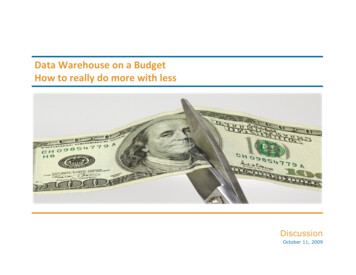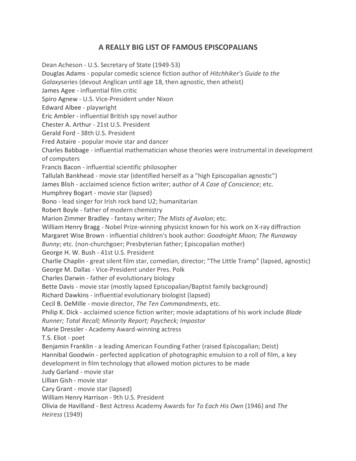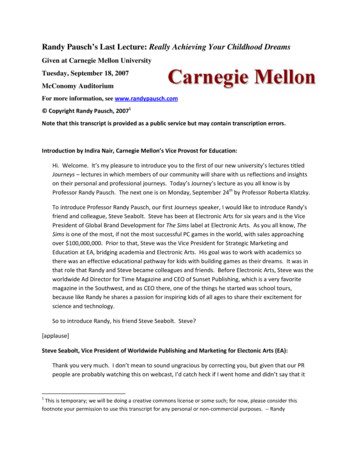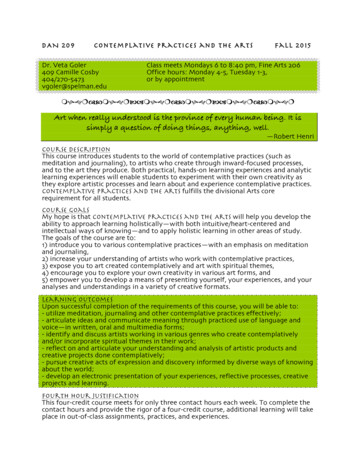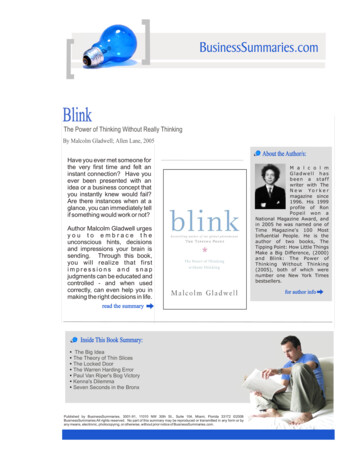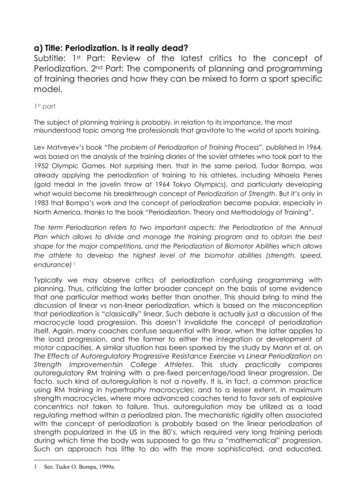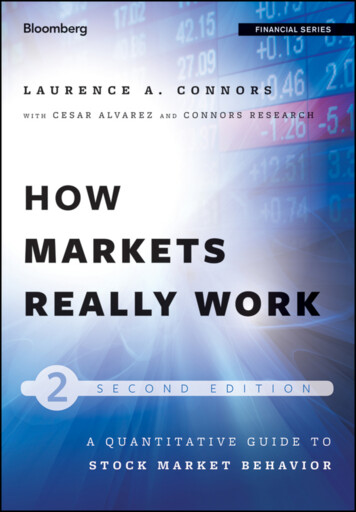
Transcription
HOW MARKETSREALLY WORKffirs.indd i25/01/12 1:46 PM
Since 1996, Bloomberg Press has published books for financial professionals on investing,economics, and policy affecting investors. Titles are written by leading practitioners andauthorities, and have been translated into more than 20 languages.The Bloomberg Financial Series provides both core reference knowledge andactionable information for financial professionals. The books are written by expertsfamiliar with the work flows, challenges, and demands of investment professionalswho trade the markets, manage money, and analyze investments in their capacity ofgrowing and protecting wealth, hedging risk, and generating revenue.For a list of available titles, please visit our website at www.wiley.com/go/bloombergpress.ffirs.indd ii25/01/12 1:46 PM
HOW MARKETSREALLY WORKA Quantitative Guide to Stock Market BehaviorSecond EditionLaurence A. ConnorsCesar AlvarezConnors Research LLCffirs.indd iii25/01/12 1:46 PM
Copyright 2012 by Laurence A. Connors and Cesar Alvarez. All rights reserved.Published by John Wiley & Sons, Inc., Hoboken, New Jersey.Published simultaneously in Canada.First edition published by The Connors Group in 2004.No part of this publication may be reproduced, stored in a retrieval system, or transmitted in any form or by anymeans, electronic, mechanical, photocopying, recording, scanning, or otherwise, except as permitted under Section107 or 108 of the 1976 United States Copyright Act, without either the prior written permission of the Publisher,or authorization through payment of the appropriate per-copy fee to the Copyright Clearance Center, Inc., 222Rosewood Drive, Danvers, MA 01923, (978) 750-8400, fax (978) 646-8600, or on the Web at www.copyright.com.Requests to the Publisher for permission should be addressed to the Permissions Department, John Wiley & Sons,Inc., 111 River Street, Hoboken, NJ 07030, (201) 748-6011, fax (201) 748-6008, or online at www.wiley.com/go/permissions.Limit of Liability/Disclaimer of Warranty: While the publisher and author have used their best efforts in preparingthis book, they make no representations or warranties with respect to the accuracy or completeness of the contentsof this book and specifically disclaim any implied warranties of merchantability or fitness for a particular purpose.No warranty may be created or extended by sales representatives or written sales materials. The advice and strategiescontained herein may not be suitable for your situation. You should consult with a professional where appropriate.Neither the publisher nor author shall be liable for any loss of profit or any other commercial damages, includingbut not limited to special, incidental, consequential, or other damages.For general information on our other products and services or for technical support, please contact our CustomerCare Department within the United States at (800) 762-2974, outside the United States at (317) 572-3993 or fax(317) 572-4002.Wiley also publishes its books in a variety of electronic formats. Some content that appears in print may not beavailable in electronic books. For more information about Wiley products, visit our website at www.wiley.com.Library of Congress Cataloging-in-Publication Data:Connors, Laurence A.How markets really work : a quantitative guide to stock market behavior / Laurence A. Connors,Cesar Alvarez. — Second edition.1 online resource. — (Bloomberg financial series ; 158)Includes index.Description based on print version record and CIP data provided by publisher; resource not viewed.ISBN 978-1-118-16650-5 (cloth); ISBN 978-1-118-22628-5 (ebk);ISBN 978-1-118-23945-2 (ebk); ISBN 978-1-118-26420-1 (ebk);1. Stock exchanges—United States. I. Alvarez, Cesar, 1967– II. Title.HG4910332.64'2—dc232011050882Printed in the United States of America10 9 8 7 6 5 4 3 2 1ffirs.indd iv25/01/12 1:46 PM
ContentsDisclaimerviiTable ExplanationixAcknowledgmentsxiCHAPTER 1Market Edges1CHAPTER 2Short-Term Highs and Short-Term Lows7CHAPTER 3Higher Highs and Lower Lows25CHAPTER 4Up Days in a Row versus Down Days in a Row43CHAPTER 5Market Breadth65CHAPTER 6Volume83CHAPTER 7Large Moves93CHAPTER 8New 52-Week Highs, New 52-Week Lows105CHAPTER 9Put/Call Ratio117vftoc.indd v25/01/12 1:47 PM
viftoc.indd viContentsCHAPTER 10Volatility Index (VIX)127CHAPTER 11The Two-Period RSI Indicator147CHAPTER 12Historical Volatility157CHAPTER 13Creating a Sample Strategy from This Research159CHAPTER 14Applying the Information in This Book163About the Authors167Index16925/01/12 1:47 PM
CHAPTER 1Market EdgesThe following is verbatim from the first edition of How Markets Really Work. It’s importantto get a point of reference of what we wrote and saw in 2004 compared to what we see with thesecond edition, which was written in late 2011. For many of us, Michael Lewis’s 1989 best-selling book Liar’s Poker was the firstinside look at what day-to-day life was like at a major Wall Street trading firm. Lewisdescribed in detail, the wheeling and dealing of some of the famous (and infamous)Wall Street titans who oversaw billions of dollars of transactions every trading dayduring the 1980s. The book remains a classic today but 14 years after it was published,Lewis outdid himself. In 2003, he published Moneyball: The Art of Winning an UnfairGame. The book chronicles the success of the Oakland A’s, who under the guidanceof their general manager, Billy Beane, used massive amounts of statistical data to helpthem successfully run their ball team.The A’s essentially turned their backs on the old school of thinking, much ofwhich was intuitive, and attempted to turn baseball into a science. Players who shouldhave been fifteenth-round draft picks were being chosen by the A’s near the top of thedraft (and signed very cheaply). These types of players were chosen not because theylooked good or the scouting reports said they couldn’t miss. They were chosen becausethe statistics said that these players had an edge and that this edge had a better chanceof playing itself out than the guessing that had gone into past selections. Essentially,Billy Beane and the A’s turned baseball upside down, and by relying upon numbersinstead of opinion, they have been able to successfully compete against teams that hadfar more money to spend on talent.The godfather behind this move to relying upon numbers instead of gut is abrilliant gentleman by the name of Bill James. In the 1970s James began publishingstudies and then books on player evaluation and baseball strategy. Up until a fewyears ago, James was all but ignored by mainstream baseball. Hall of Fame manager1c01.indd 125/01/12 1:40 PM
2How Markets Really WorkSparky Anderson, who is the only manager to win a World Series in both the NationalLeague and the American League, referred to James as “a fat guy with a beard whoknows nothing about nothing.” And in spite of the success that the A’s and a few otherteams have had relying upon statistics, the debate still rages as to its effectiveness. But, asthis is being written, baseball has begun the process of turning away from the SparkyAnderson school of knowledge and accepting the thinking of people like Bill James.General managers are being hired by teams not for their baseball playing careers ortheir baseball prowess, but for their ability to analyze baseball statistics and makecorrect decisions using these statistics. Teams like the Red Sox and the Dodgers nowhave GMs who are only in their early thirties. Why are they entrusted with franchisesthat are valued in the hundreds of millions of dollars? It’s because these guys don’tguess. They know numbers and their understanding of these numbers provides them withan edge.And in some cases, this edge is substantial.What does this have to do with trading? A lot. After we read Moneyball, weremarked that it’s amazing that baseball has gone this route yet most of Wall Street stillhas not. If baseball has quantified mainstream parts of the game such as batting average, on base percentage, errors, steals, walks, and so on, why hasn’t Wall Street done thesame with the indicators it relies upon every day? Trading day after trading day, we arebombarded with information from the media. “The market rose for the third straightday as the bulls are taking charge.” What does this mean? It sounds good, doesn’t it?It sure feels as though the market is going to continue to rise. A market rising threedays in a row is usually rising because of good news. Isn’t that a precursor of things tocome? What about advancing issues and declining issues? On days when the marketdrops sharply and declining stocks far outnumber advancing stocks, the press and theanalysts tell us this is bad. Poor market breadth is supposedly a sign of future weakness.It seems to make sense. But is it true? (You’ll soon see it’s not.)Just as old school baseball used to think that a guy who was 6 3 and could run fastand hit the ball a mile was a can’t-miss prospect, much of old-school Wall Street stillthinks that good news and market strength is a sign of future upward price movementand bad news and poor market strength is a sign of future downward movement. As youwill soon learn, at least looking at the market over the past 15 years (1989–2003), thereis nothing further from the truth. This is not our opinion or guess. It’s what the statisticsshow. And just as baseball had a tough time accepting the fact that on-base percentageis more important than batting average, we suspect that many people on Wall Street,especially the media and the mainstream firms, will have a tough time accepting the factthat it’s better over the near term for the market to have dropped than for it to have risen.All combined, we have nearly three decades of trading and research experiencebehind us. Much of what you will learn from this book is a culmination of our work.We looked at a number of the most common ways traders, analysts, and the presslook at the market. Even though we went into the tests having a strong clue wherethe results would end up, even we were surprised at some of these results. The testsincluded us looking at how the S&P 500 cash market (SPX) and the Nasdaq 100 cashmarket (NDX) did over a 1-day, 2-day, and 1-week period after they made a 5-periodc01.indd 225/01/12 1:40 PM
Market Edges3high, 10-period high, 5-period low, and 10-period low (intraday). We also looked athow these markets did after prices rose multiple days in a row (showing strength) anddeclined multiple days in a row (showing weakness). We looked at the times when themarkets made multiple-day higher highs and multiple-day lower lows, again lookingat what happened after continuous strength and weakness. From there we looked atthe days when the market rose sharply to the upside versus declined sharply to thedownside.Volume was another topic we tackled, as it is one of the most often-used indicators. After volume, you’ll learn about market breadth when we analyze what themarket has done after advancing issues outperformed declining issues (and viceversa). The results from many of these chapters may surprise you, and this chaptermay be the biggest surprise.From there, we looked at another common indicator: new 52-week highs andnew 52-week lows. There’s a healthy edge here, and again it’s not where the analystsand the press say it is. In the final two chapters, we’ll show you how to use the put/call ratio and the volatility index (VIX)—Chicago Board Options Exchange (CBOE)Volatility Index. Each indicator has shown strong consistent edges, and we’ll teachyou where these edges are.Before we move to the next chapter and start looking at the test results, we’d liketo cover a few guidelines to help you better understand how to use this book andhow to use the information presented to help gain a greater edge in your tradingand investing.1. We’ll state this again later in the book, but you need to know that there are noassurances that these test results will hold up in the future. Even though manyof these tests are independent of one another and basically lead to the sameconclusion, it cannot be assumed this conclusion (or any market conclusion)will hold true in the future.2. Much of Wall Street is made up of opinions. It’s also made up of opinions that arenot backed by any statistical evidence. If the baseball world can do it, then WallStreet can do it, too. Hopefully, this book is just the tip of the iceberg in usingstatistics to help understand how markets behave and how one can make properand rational decisions on a day-to-day basis.3. All these tests were run on the cash market and were not actual trades. Also,commissions and slippage were not factored in.4. All the tests use a benchmark. This means we compared apples to apples. We lookedat the results when certain situations occurred versus how the market performedon average during the same time period. We did the same for the percentage oftrades that showed gains. In many cases we could have shown more test results,but we didn’t because the number of opportunities that occurred (the sample size)was too low.5. We tested the S&P 500 and the Nasdaq 100 cash markets throughout the book.6. Many of the tests run as far back as 15 years. This encompassed a solid bull market,followed by a very severe bear market, followed by a rally in 2003. The net biasc01.indd 325/01/12 1:40 PM
47.8.9.10.11.12.How Markets Really Workwas up for the entire time frame, but the market also saw some healthy sellingperiods, especially from 2000 to 2002.Finding clean market data is not as easy as one would think. There are datavendors whose data we could not trust. Therefore, we used data from sourceswe trusted, including the CBOE for the put/call ratio tests and the VIX tests.In many cases we tested up to 15 years of data, but in some cases we had to usefewer years in order not to compromise the integrity of the test results. These testswere run multiple times in order to assure the results. If yo
Laurence A. Connors Cesar Alvarez Connors Research LLC HOW MARKETS REALLY WORK A Quantitative Guide to Stock Market Behavior Second Edition fffirs.indd iiifirs.indd iii 225/01/12 1:46 PM5/01/12 1:46 PM

